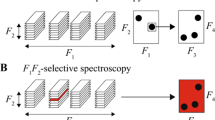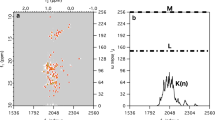Abstract
We describe a novel method for the robust, rapid, and reliable determination of J couplings in multi-dimensional NMR coupling data, including small couplings from larger proteins. The method, “High-resolution Iterative Frequency Identification of Couplings” (HIFI-C) is an extension of the adaptive and intelligent data collection approach introduced earlier in HIFI-NMR. HIFI-C collects one or more optimally tilted two-dimensional (2D) planes of a 3D experiment, identifies peaks, and determines couplings with high resolution and precision. The HIFI-C approach, demonstrated here for the 3D quantitative J method, offers vital features that advance the goal of rapid and robust collection of NMR coupling data. (1) Tilted plane residual dipolar couplings (RDC) data are collected adaptively in order to offer an intelligent trade off between data collection time and accuracy. (2) Data from independent planes can provide a statistical measure of reliability for each measured coupling. (3) Fast data collection enables measurements in cases where sample stability is a limiting factor (for example in the presence of an orienting medium required for residual dipolar coupling measurements). (4) For samples that are stable, or in experiments involving relatively stronger couplings, robust data collection enables more reliable determinations of couplings in shorter time, particularly for larger biomolecules. As a proof of principle, we have applied the HIFI-C approach to the 3D quantitative J experiment to determine N-C′ RDC values for three proteins ranging from 56 to 159 residues (including a homodimer with 111 residues in each subunit). A number of factors influence the robustness and speed of data collection. These factors include the size of the protein, the experimental set up, and the coupling being measured, among others. To exhibit a lower bound on robustness and the potential for time saving, the measurement of dipolar couplings for the N-C′ vector represents a realistic “worst case analysis”. These couplings are among the smallest currently measured, and their determination in both isotropic and anisotropic media demands the highest measurement precision. The new approach yielded excellent quantitative agreement with values determined independently by the conventional 3D quantitative J NMR method (in cases where sample stability in oriented media permitted these measurements) but with a factor of 2–5 in time savings. The statistical measure of reliability, measuring the quality of each RDC value, offers valuable adjunct information even in cases where modest time savings may be realized.




Similar content being viewed by others
References
Andrec M, Du P, Levy RM (2001) Protein structural motif recognition via NMR residual dipolar couplings. J Am Chem Soc 123:1222–1229
Atreya HS, Garcia E, Shen Y, Szyperski T (2007) J-GFT NMR for precise measurement of mutually correlated nuclear spin-spin couplings. J Am Chem Soc 129:680–692
Bax A (2003) Weak alignment offers new NMR opportunities to study protein structure and dynamics. Protein Sci 12:1–16
Bryce DL, Bax A (2004) Application of correlated residual dipolar couplings to the determination of the molecular alignment tensor magnitude of oriented proteins and nucleic acids. J Biomol NMR 28:273–287
Chou JJ, Delaglio F, Bax A (2000) Measurement of one-bond N-15-C-13′ dipolar couplings in medium sized proteins. J Biomol NMR 18:101–105
Clore GM, Schwieters CD (2003) Docking of protein–protein complexes on the basis of highly ambiguous intermolecular distance restraints derived from H-1(N)/N-15 chemical shift mapping and backbone N-15-H-1 residual dipolar couplings using conjoined rigid body/torsion angle dynamics. J Am Chem Soc 125:2902–2912
Cordier F, Grzesiek S (1999) Direct observation of hydrogen bonds in proteins by interresidue 3HJNC′ scalar couplings. J Am Chem Soc 121:1601–1602
Cornilescu G, Marquardt JL, Ottinger M, Bax A (1998) Validation of protein structure from anisotropic carbonyl chemical shifts in a dilute liquid crystalline phase. J Am Chem Soc 120:6836–6837
Cornilescu G, Hu JS, Bax A (1999a) Identification of the hydrogen bonding network in a protein by scalar couplings. J Am Chem Soc 121:2949–2950
Cornilescu G, Ramirez BE, Frank MK, Clore GM, Gronenborn AM, Bax A (1999b) Correlation between 3H J NC’ and hydrogen bond length in proteins. J Am Chem Soc 121:6275–6279
Cornilescu G, Cornilescu CC, Zhao Q, Frederick RO, Peterson FC, Thao S, Markley JL (2004) Letter to the Editor: Solution structure of a homodimeric hypothetical protein, At5g22580, a structural genomics target from Arabidopsis thaliana. J Biomol NMR 29:387–390
Delaglio F, Grzesiek S, Vuister GW, Zhu G, Pfeifer J, Bax A (1995) NMRPIPE – a multidimensional spectral processing system based on UNIX pipes. J Biomol NMR 6:277–293
Delaglio F, Kontaxis G, Bax A (2000) Protein structure determination using molecular fragment replacement and NMR dipolar couplings. J Am Chem Soc 122:2142–2143
Ding K, Gronenborn AM (2002) Novel 2D triple-resonance NMR experiments for sequential resonance assignments of proteins. J Magn Reson 156:262–268
Eghbalnia HR, Bahrami A, Tonelli M, Hallenga K, Markley JL (2005) High-resolution iterative frequency identification for NMR as a general strategy for multidimensional data collection. J Am Chem Soc 127:12528–12536
Gallagher T, Alexander P, Bryan P, Gilliland GL (1994) 2 crystal-structures of the B1 immunoglobulin-binding domain of streptococcal protein-G and comparison with NMR. Biochemistry 33:4721–4729
Hansen MR, Mueller L, Pardi A (1998) Tunable alignment of macromolecules by filamentous phage yields dipolar coupling interactions. Nat Struct Biol 5:1065–1074
Hoshino M, Otting G (2004) Sensitivity-enhanced double-TROSY experiment for simultaneous measurement of one-bond 15N–1H, 15N–13C′ and two-bond 1H–13C′ couplings. J Magn Reson 171:270–276
Hus JC, Marion D, Blackledge M (2000) De novo determination of protein structure by NMR using orientational and long-range order restraints. J Mol Biol 298:927–936
Kim S, Szyperski T (2003) GFT NMR, a new approach to rapidly obtain precise high-dimensional NMR spectral information. J Am Chem Soc 125:1385–1393
Kover KE, Batta G (2004) More line narrowing in TROSY by decoupling of long-range couplings: shift correlation and 1JNC′ coupling constant measurements. J Magn Reson 170:184–190
Kupce E, Freeman R (2003) Reconstruction of the three-dimensional NMR spectrum of a protein from a set of plane projections. J Biomol NMR 27:383–387
Meissner A, Duus JO, Sorensen OW (1997) Spin-state-selective excitation. Application for E.COSY-type measurement of JHH coupling constants. J Magn Reson 128:92–97
Ottiger M, Bax A (1998) Characterization of magnetically oriented phospholipid micelles for measurement of dipolar couplings in macromolecules. J Biomol NMR 12:361–372
Ottiger M, Delaglio F, Bax A (1998a) Measurement of J and dipolar couplings from simplified two-dimensional NMR spectra. J Magn Reson 131:373–378
Ottiger M, Delaglio F, Marquardt JL, Tjandra N, Bax A (1998b) Measurement of dipolar couplings for methylene and methyl sites in weakly oriented macromolecules and their use in structure determination. J Magn Reson 134:365–369
Permi P, Heikkinen S, Kilpelainen I, Annila A (1999) Measurement of 1JNC′ and 2JHNC′ couplings from spin-state- selective two-dimensional correlation spectrum. J Magn Reson 140:32–40
Qu YX, Guo JT, Olman V, Xu Y (2004) Protein structure prediction using sparse dipolar coupling data. Nucleic Acids Res 32:551–561
Reiter NJ, Lee D, Wang YX, Tonelli M, Bahrami A, Cornilescu CC, Butcher SE (2006) Resonance assignments for the two N-terminal RNA recognition motifs (RRM) of the S. cerevisiae pre-mRNA processing protein Prp24. J Biomol NMR 36:58
Sattler M, Schleucher J, Griesinger C (1999) Heteronuclear multidimensional NMR experiments for the structure determination of proteins in solution employing pulsed field gradients. Prog Nucl Magn Reson Spectrosc 34:93–158
Simorre JP, Brutscher B, Caffrey MS, Marion D (1994) Assignment of NMR-spectra of proteins using triple-resonance 2-dimensional experiments. J Biomol NMR 4:325–333
Szyperski T, Wider G, Bushweller JH, Wuthrich K (1993) 3D C-13-N-15-heteronuclear 2-spin coherence spectroscopy for polypeptide backbone assignments in C-13-N-15-double-labeled proteins. J Biomol NMR 3:127–132
Szyperski T, Yeh DC, Sukumaran DK, Moseley HNB, Montelione GT (2002) Reduced-dimensionality NMR spectroscopy for high-throughput protein resonance assignment. Proc Natl Acad Sci USA 99:8009–8014
Tjandra N, Bax A (1997) Direct measurement of distances and angles in biomolecules by NMR in a dilute liquid crystalline medium. Science 278:1111–1114
Tjandra N, Omichinski JG, Gronenborn AM, Clore GM, Bax A (1997) Use of dipolar 1H–15N and 1H–13C couplings in the structure determination of magnetically oriented macromolecules in solution. Nat Struct Biol 4:732–738
Tolman JR, Flanagan JM, Kennedy MA, Prestegard JH (1995) Nuclear magnetic dipole interactions in field-oriented proteins: information for structure determination in solution. Proc Natl Acad Sci USA 92:9279–9283
Wang LC, Donald BR (2004) Exact solutions for internuclear vectors and backbone dihedral angles from NH residual dipolar couplings in two media, and their application in a systematic search algorithm for determining protein backbone structure. J Biomol NMR 29:223–242
Wang YX, Jacob J, Cordier F, Wingfield PT, Stahl SJ, Lee-Huang S, Torchia DA, Grzesiek S, Bax A (1999) Measurement of 3H J NC′ connectivities across hydrogen bonds in a 30 kDa protein. J Biomol NMR 14:181–184
Wedemeyer WJ, Rohl CA, Scheraga HA (2002) Exact solutions for chemical bond orientations from residual dipolar couplings. J Biomol NMR 22:137–151
Acknowledgments
We thank Ad Bax and Sam Butcher for allowing us to use their protein samples GB3 and Prp24-12, respectively, in this study. This research was carried out in the National Magnetic Resonance Facility at Madison, which is supported by Biomedical Research Technology Program, National Center for Research Resources, through NIH grant P41 RR02301 and utilized equipment funded by the University of Wisconsin, the NSF Academic Infrastructure Program (BIR-9214394), the NIH Shared Instrumentation Program (RR02781, RR08438), the NIH Research Collaborations to Provide 900 MHz NMR Spectroscopy (GM66326), the NSF Biological Instrumentation Program (DMB-8415048), and the U.S. Department of Agriculture. A.B. received partial support from the National Institute of General Medical Science’s Protein Structure Initiative through NIH grant 1 P50 GM64598, which supports the Center for Eukaryotic Structural Genomics. H.E. was supported in part by the National Library of Medicine under grant 1K22LM8992.
Author information
Authors and Affiliations
Corresponding authors
Electronic supplementary material
Below is the link to the electronic supplementary material.
10858_2007_9173_MOESM1_ESM.doc
One figure with correlation plots between experimental (obtained by 3D and HIFI-C methods) and GB3 structure fitted RDCs, one table containing the statistical analysis of isotropic couplings extracted from three different HIFI-C tilt angles for protein At5g22580.1, one table containing three outliers in the comparison of RDCs measured by the HIFI-C and 3D quantitative J methods for protein GB3, one table containing the analysis of the outliers in the comparison between NC′ RDC values measured by the HIFI-C and 3D quantitative J methods for the 25 kDa homodimeric At5g22580.1 protein, one figure with the At5g22580.1 correlation between RDCs extracted from the 3D experiment versus those from HIFI-C at three tilted plane angles (28°, 57° and 77°), one figure with the At5g22580.1 correlation between the NC′ couplings from each pair of “+/−” HIFI-C tilt planes (for three tilt angles: 28°, 57° and 77°) in isotropic and aligned state, one figure with comparisons of the At5g22580.1 NC′ couplings between different HIFI tilt planes in isotropic state and aligned states, two plots comparing 1D traces from the 3D experiment with those from the 2D HIFI-C planes for GB3 protein in isotropic and aligned states, respectively, and two plots comparing the 1D traces from the 3D experiment with those from the 2D HIFI-C planes for the At5g22580.1 protein, in isotropic and aligned states, respectively.
ESM1 (DOC 921 kb)
Rights and permissions
About this article
Cite this article
Cornilescu, G., Bahrami, A., Tonelli, M. et al. HIFI-C: a robust and fast method for determining NMR couplings from adaptive 3D to 2D projections. J Biomol NMR 38, 341–351 (2007). https://doi.org/10.1007/s10858-007-9173-7
Received:
Revised:
Accepted:
Published:
Issue Date:
DOI: https://doi.org/10.1007/s10858-007-9173-7




